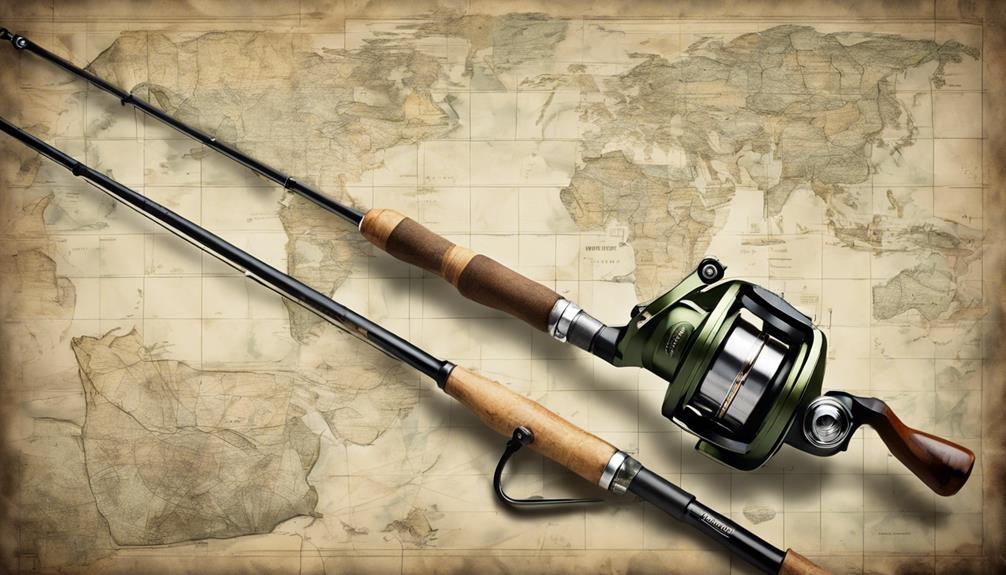Throughout history, a plethora of potent forces have shaped the framework of fishing and angling regulations. From ancient traditions to modern globalization, a myriad of influences have played a pivotal role in molding the rules governing these aquatic pursuits.
As you uncover the layers of history and societal shifts, you will find a complex interplay of factors that have left an indelible mark on the laws that govern fishing practices. The intricate web of influences that have converged to form these regulations is a testament to the multifaceted nature of this evolving field.
Early Influences on Fishing Laws
Exploring the roots of fishing regulations reveals how early societies structured their angling practices to maintain fish populations. Feudal restrictions played a significant role in shaping early fishing laws. During the Middle Ages, rulers imposed strict regulations on who could fish in certain waters, often reserving these rights for the nobility. This system not only controlled access to fishing grounds but also helped prevent overfishing in limited water bodies.
Environmental concerns also influenced early fishing regulations. Communities recognized the importance of preserving fish stocks for future generations. Some societies implemented seasonal fishing bans to allow fish populations to replenish and ensure sustainable harvesting practices. These early conservation efforts laid the foundation for modern fisheries management strategies.
Religious practices further shaped fishing laws in many early civilizations. For example, in medieval Europe, certain days were designated as fish-only days due to religious fasting traditions. These regulations not only influenced when people could fish but also contributed to the development of specific fishing techniques geared towards catching fish more effectively during these periods.
Economic influences were another driving force behind early fishing regulations. Fish and other aquatic resources were valuable commodities, leading rulers to enact laws to regulate trade and protect local economies. By controlling who could fish, where, and when, authorities aimed to maintain a steady supply of fish for both local consumption and commercial purposes.
Evolution of Angling Restrictions
Throughout history, angling restrictions have evolved in response to changing societal needs and environmental pressures. Societal norms play a significant role in shaping angling regulations. In the past, practices such as overfishing were common due to a lack of awareness about conservation. As societal values shifted towards sustainability, regulations were introduced to preserve fish populations and their habitats. Concerns about the impact of angling on the environment have led to restrictions on catch limits, fishing seasons, and the use of certain equipment to prevent overexploitation of fish stocks.
Economic influences also drive the evolution of angling restrictions. Governments and local authorities often implement regulations to maintain a balance between commercial fishing activities and recreational angling. Economic considerations, such as the revenue generated from sport fishing tourism, can influence the establishment of marine protected areas or the enforcement of size limits to ensure the long-term viability of fish populations.
Moreover, technological advancements have necessitated updates to angling regulations. Innovations in fishing gear, such as sonar technology and advanced fishing vessels, have increased the efficiency of angling practices. To prevent these advancements from negatively impacting fish populations, regulations have been adapted to address issues like bycatch and unsustainable fishing methods. Adapting regulations to keep pace with technological developments is crucial in ensuring the sustainability of angling practices for future generations.
Impact of Industrialization on Regulations
The industrial revolution brought significant changes to angling regulations as the impact of industrialization on fishing practices and ecosystems became increasingly apparent. With the rise of industrial activities such as mining, manufacturing, and urban development, environmental concerns regarding water pollution, habitat destruction, and overfishing started to emerge. These environmental issues directly influenced the need for stricter fishing regulations to protect dwindling fish populations and fragile aquatic ecosystems.
Moreover, the economic implications of industrialization played a crucial role in shaping fishing regulations. The growth of industries led to increased demand for fish as a food source and for commercial purposes, resulting in intensified fishing pressure on already stressed fish stocks. This overexploitation threatened the sustainability of fish populations, prompting authorities to implement catch limits, size restrictions, and fishing seasons to ensure the long-term viability of fisheries.
As industrialization accelerated, governments and conservation organizations began collaborating to establish conservation measures and enforce regulations to mitigate the negative impacts of industrial activities on aquatic environments. Through these efforts, a balance between economic interests and environmental conservation was sought, emphasizing the importance of sustainable fishing practices to preserve marine biodiversity and ensure the well-being of future generations. The industrial revolution thus marked a pivotal period in the history of angling regulations, highlighting the necessity of adapting rules to address the evolving challenges posed by industrialization.
Cultural Factors in Fishing Rules
Considering the diverse traditions and beliefs surrounding fishing practices, cultural factors significantly influence the formulation of fishing rules worldwide. Cultural norms and values play a crucial role in shaping fishing regulations, reflecting societies' attitudes towards nature and resource management.
Here are four key points highlighting the impact of cultural factors on fishing rules:
- Traditional Practices: Many fishing regulations are rooted in traditional fishing practices that have been passed down through generations. These rules often aim to preserve cultural heritage and maintain sustainable fishing methods that have been practiced for centuries.
- Societal Norms: Fishing rules are also influenced by societal norms regarding conservation, animal welfare, and resource utilization. These norms guide policymakers in creating regulations that align with the values and beliefs of the community.
- Cultural Taboos: Certain cultures have specific taboos or rituals associated with fishing, which can lead to the development of rules that respect these cultural sensitivities. For example, some communities may have restrictions on fishing during religious ceremonies or at certain times of the year.
- Indigenous Perspectives: Indigenous peoples often have unique perspectives on fishing and natural resource management based on their deep connection to the land. Fishing regulations may incorporate indigenous knowledge and practices to ensure sustainable fishing practices and respect for cultural traditions.
Technological Advances and Policy Changes
Enhancing regulatory frameworks in response to technological advancements and evolving policies is crucial for ensuring effective and adaptable fishing management strategies. Technological innovations have significantly impacted fishing practices, leading to the need for updated policies and regulations to address new challenges and opportunities in the fishing industry.
Governmental oversight plays a crucial role in monitoring and regulating the use of advanced technologies in fishing. As new tools and methods such as GPS tracking, fish finders, and drones become more prevalent, it's essential for policymakers to stay informed and responsive to these changes. By implementing regulations that govern the use of such technologies, authorities can ensure sustainable fishing practices and prevent overexploitation of marine resources.
Furthermore, policy changes are essential to address emerging issues such as bycatch, illegal fishing, and habitat destruction. Governments must work closely with industry stakeholders to develop regulations that balance conservation efforts with economic interests. By leveraging technological advancements to improve data collection, monitoring, and enforcement capabilities, policymakers can enhance compliance with fishing regulations and promote responsible fishing practices.
Role of Conservation in Angling Laws
Incorporating conservation principles into angling laws ensures sustainable management of fish populations and habitats, aligning with the evolving needs of the fishing industry. Here are four key aspects highlighting the role of conservation in angling laws:
- Sustainability Practices: Angling laws often enforce catch limits, size regulations, and designated fishing zones to prevent overfishing and promote sustainable practices. By implementing these measures, authorities aim to maintain healthy fish populations for future generations.
- Wildlife Management: Conservation in angling laws goes beyond just fish populations. It also encompasses the protection of habitats essential for various wildlife species. Regulations may include restrictions on fishing in sensitive areas to safeguard ecosystems and biodiversity.
- Ecosystem Health: Angling laws play a crucial role in preserving the overall health of aquatic ecosystems. By controlling fishing activities, authorities can prevent disruptions to food chains, reduce habitat degradation, and promote balanced ecological conditions.
- Community Engagement: Conservation-focused angling laws often involve community participation and education initiatives. By raising awareness about the importance of sustainable practices, stakeholders are encouraged to actively contribute to wildlife management efforts and foster a sense of responsibility towards the environment.
Political Forces Shaping Regulations

Political forces significantly influence the shaping of angling regulations, impacting decisions on resource management and conservation efforts. Lobbying efforts play a key role in swaying policymakers to enact regulations that favor specific interest groups within the fishing industry. Various organizations and companies engage in lobbying activities to promote their agendas, influencing the development and implementation of fishing policies. Through lobbying efforts, these groups seek to shape regulations that align with their economic goals while potentially disregarding long-term sustainability and conservation principles.
Government influence is another crucial factor in determining angling regulations. Elected officials and government agencies have the authority to establish, enforce, and amend fishing laws based on political considerations, public opinion, and scientific advice. The political landscape can greatly impact the direction of fishing regulations, as different administrations may prioritize economic interests, conservation efforts, or recreational angling opportunities. Changes in government leadership can lead to shifts in regulatory focus, affecting the management of fish stocks, habitat protection, and access to fishing grounds.
Globalization's Effect on Fishing Policies
Globalization has reshaped fishing policies worldwide, altering the dynamics of resource management and commercial practices in the industry. Here's how this phenomenon has influenced fishing policies:
- Increased Competition: Globalization has opened up markets, leading to more players in the fishing industry. This heightened competition puts economic pressures on fishing policies to remain competitive.
- Overexploitation Concerns: With easier access to global markets, there are concerns about overfishing and depletion of marine resources. Fishing policies need to address these environmental concerns to ensure sustainability.
- Technology Transfer: Globalization has facilitated the transfer of advanced fishing technologies between countries. This transfer impacts fishing policies as nations adopt new practices to stay current with industry standards.
- Trade Agreements: International trade agreements influence fishing policies by setting standards for fishing practices and regulating the flow of seafood products. These agreements can impact how countries address economic pressures and environmental concerns in their fishing policies.
Globalization's effect on fishing policies is profound, as countries navigate economic pressures while striving to address environmental concerns to ensure the sustainability of marine resources.
Frequently Asked Questions
How Did Religious Beliefs Influence Early Fishing Laws and Regulations?
Religious beliefs impacted early fishing laws and regulations. Cultural influences played a significant role in shaping these rules. People's religious convictions often guided how they viewed and interacted with nature, including fishing practices.
These beliefs influenced what was considered acceptable or unacceptable behavior when it came to fishing, leading to the creation of specific laws and regulations to govern these activities.
What Role Did Gender Play in Shaping Historic Fishing and Angling Regulations?
When considering historic fishing and angling regulations, gender perspectives and societal norms played a significant role. Women were often excluded or restricted in fishing activities due to traditional beliefs about gender roles.
Society's expectations influenced regulations, with fishing seen as a male-dominated activity. These gender biases shaped rules and access to fishing resources, reflecting broader societal attitudes towards women and their involvement in outdoor activities.
How Did Economic Factors Impact the Evolution of Angling Restrictions?
When it comes to the evolution of angling restrictions, economic influences have played a significant role. Societal norms and economic factors have shaped regulations throughout history.
Factors like market demand, resource availability, and commercial interests have all influenced the development of angling restrictions. Understanding how economic influences interact with societal norms is crucial in comprehending the reasoning behind these regulations.
Were There Any Significant Conflicts or Wars That Had a Direct Impact on Fishing Regulations Throughout History?
During significant conflicts or wars, military conflicts often led to shifts in fishing regulations as nations sought to regulate resources for strategic purposes.
Diplomatic treaties also played a role in shaping fishing regulations by establishing agreements on resource management and conservation efforts.
These historical events influenced the development of angling restrictions and highlighted the interconnectedness between geopolitical factors and fishing regulations.
How Did Traditional Practices and Customs of Indigenous Communities Influence Fishing Rules and Regulations?
Incorporating cultural traditions, indigenous communities greatly influenced fishing rules and regulations. Their practices, passed down through generations, prioritized environmental conservation. By respecting nature and its resources, these communities shaped sustainable fishing practices that continue to impact regulations today.
Understanding their deep connection to the land and sea helps to appreciate the significant role indigenous customs played in developing modern fishing guidelines.
Conclusion
Overall, historic fishing and angling regulations have been shaped by a variety of factors, including early influences, industrialization, cultural norms, technological advances, conservation efforts, political forces, and globalization.
These regulations have evolved over time to protect fish populations, promote sustainable fishing practices, and ensure the long-term health of our oceans and waterways.
By considering these diverse influences, policymakers can continue to develop effective and equitable fishing policies for the future.



